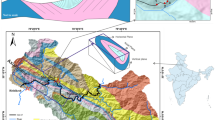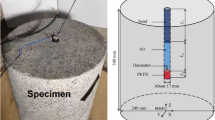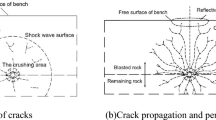Abstract
Natural discontinuities as well as mechanical properties are the difficult-to-control parameters that significantly influence the fragmentation of marble after blasting. In Central Africa, the Bidzar quarry is the only one producing marble, plagued for decades by block fragmentation problems, requiring multiple blasts that cause huge costs and environmental problems. The objective of this study is to predict the fragmentation of the Bidzar rock quarry and to improve its geological and mechanical knowledge using the Kuz–Ram method. Thus, blastability as a function of the dip of the discontinuity planes as well as fragmentation as a function of the powder factor, compressive strength and drilling mesh were studied. The results obtained show that, the rock quarry is heterogeneous, consisting mainly of fissured marble of medium hardness. Its dip is about 85°, its rock factor is 10.455 and it is class III, with a difficult blastability of 0.2654 kg/m3. The marble from the Bidzar quarry is of excellent quality with an RQD of 93%.The fractures and discontinuity planes are spaced and of class ES2. The density of the fractures and discontinuity planes is low and of class ID2.The rock quarry is intercepted by a network of discontinuity planes marked by three families of direction, major (N30–40E, N40–50E, N160–170E), secondary (N10–20E, N50–60E, N80–90E, N140–150E, N150–160E, N170–180E) and minority (N00–10E, N20–30E, N40–50E, N70–80E, N100–110E, N110–120E, N120–130E, N130–140E). Finally, the variation in fragmentation intensity is caused by differences in the dips of the blasting planes, their compressive strength, and the variation in the drilling mesh.








Similar content being viewed by others
References
Akbari M, Lashkaripour G, Yarahamdi BA, Ghafoori M (2015) Blastability evaluation for rock mass fragmentation in Iran central iron ore mines. Int J Min Sci Technol 25:59–66. https://doi.org/10.1016/j.ijmst.2014.11.008
Ash RL (1973) The influence of geological discontinuities on rock blasting, Ph.D. Thesis, University of Missouri Rolla 87
Belhous M (2016) Elaboration d’un plan de tir pour améliorer la fragmentation des roches -Cas de la carrière d’Ain El Kebira, Université Abderrahmane Mira de Bejaia, Faculté de Technologie, Département des mines et géologie, mémoire en vue de l’obtention du diplôme de master en mines option exploitation minière
Belland JM (1968) Structure as a control in rock fragmentation coal lake iron ore deposited. The Canadian Mining Metallurgical Bull 59(647):323–328
Blair AC (2015) A novel powder factor based bench blast design method for large surface coalmines. Doctoral dissertations, Missouri University of Science and Technology
Burkle WC (1979) Geology and its effect on blasting. In: Proceedings of the 5th conference on explosives and blasting techniques, SEE
Cho SH, Katsuhiko K (2004) Rock fragmentation control in blasting. Mining Mater Process Inst Japan, Mater Trans 45(5):1722–1730
Cruise J (2011) Rock breaking—a science, not an art. Southern African Institute of Mining and Metallurgy, Namibia
Cunningham CV (1983) The Kuz-Ram model for the prediction of fragmentation from blasting, proceedings of the international symposium on rock fragmentation and blasting, Lulea, August 22–26
Cunningham CV (1987) Fragmentation estimations and the Kuz-Ram model-four years on, proceedings of the second international symposium on rock fragmentation by blasting, Keystone, August 23–26
Cunningham CV (2005) The Kuz-Ram fragmentation model-20 years on, 2005. In: European federation of explosives engineers, Brighton conference proceeding. Brighton, UK, pp 201–210
De Lile F (2012) Recherche d'une prédiction de fragmentation charge par charge pour les tirs à ciel ouvert, Ecole des mines de Paris, Thèse de Doctorat
Ebrahimi E, Monjezi M, Khalesi MR, Armaghani DJ (2015) Prediction and optimization of back-break and rock fragmentation using an artificial neural network and a bee colony algorithm. Bull Eng Geol Environ, Springer-Verlag Berlin Heidelberg, pp 1–10. http://doi.org//https://doi.org/10.1007/s10064-015-0720-2
Gadikor J (2018) Optimization of drilling and blasting practices at a Western US open pit copper mine. Graduate Theses and Non-Theses. 168, Master of Science in Mining Engineering Montana Tech
Gaucher F (2011). Planification des travaux de sautage excavation par bancs à ciel ouvert d'une carrière de calcaire fossilifère. Goldman Exploration, 860 boul. de la Chaudière Québec, Qc, G1X 4B7Le 31 octobre 2011
Gheibie S, Aghababaei H, Hoseinie SH, Pourrahimian Y (2009) Modified Kuz-Ram fragmentation model and its use at the Sungun copper Mine. Int J Rock Mech Min Sci 46(2009):967–973
Huang J, Asteris PG, Pasha SMK, Ahmed Salih Mohammed AS, Hasanipanah M (2020) A newauto-tuning model for predicting the rock fragmentation: a cat swarm optimization algorithm. Engineering with Computers, Springer-Verlag London Ltd., part of Springer Nature, pp 1–12. https://doi.org/10.1007/s00366-020-01207-4
Hustrulid W (1999) Blasting principles for open pit mining, vol 1. A.A. Balkema Pub
Jug J, Stjepan S, Gazdek M, Kavur B (2017) Fragment size distribution of blasted rock mass. World multidisciplinary earth sciences symposium (WMESS 2017) IOP publishing, OP Conf. Series: Earth and Environmental Science 95 042013, pp 1–2
Kuznetsov VM (1973) The mean diameter of fragments formed by blasting rock. J Min Sci 9:144–148
Langefors U, Kihlstrom B (1973) The modern technique of rock blasting. John Wiley & Sons, New York, London, Sydney, Toronto
Langefors U, Kihlstrom B (1979) The modern technique of rock blasting, AWE/Gebers, Stockholms, Suede
M’zonchem K and Chenafa W (2006) Etude géotechnique de la stabilité des talus dans la carrière de Ain El Kebira. Mémoire de finn d’étude du diplôme d’ingénieur d’état en géologie, Université de Sétif
Meftah A (2010) Méthode de soutènements des écrans de soutènements, chapitre 2
Mohammad B, Mohammad A, Farhang S, Farzad S, Sadjad M (2019) A new framework for evaluation of rock fragmentation in open pit mines. Faculty of mining engineering, petroleum and geophysics, Shahrood University of technology, Shahrood, Iran. J Mech Geotech Eng 11:325–336
Muftuoglu Y, Amehmetoglu A, Karpuz C (1991) Correlation of powder factor with physical rock properties and rotary drill performance in Turkish surface coal mines. In: Wittke, W. (Ed.), The 7th ISRM Congress. International Society for Rock. Mechanics, Aachen, Germany
Ndjeng E (1998) Sedimentary structures of the Babouri-Figuil basin (Bénoué ditch) in North Cameroon. In geoscience of Cameroon as Vicat J and Bilong P, collect GEOCAM 1/1998, Press University of Yaounde I
Ouchterlony F, Sanchidrián JA (2019) Review of development of better prediction equations for blast fragmentation. J Rock Mech Geotech Eng 11:1094–1109
Porokhovoï E (1995) Stabilité à long terme des talus de mines à ciel ouvert dans les massifs de roches basiques et ultrabasiques, Thèse de Doctorat, Ecole nationale des ponts et chaussées en géologie de l'ingénieur
Rosin P, Rammler E (1933) The laws governing the fineness of powdered coal. J Inst Fuel 7:29–36
Salmi EF, Sellers EJ (2021) A review of the methods to incorporate the geological and geotechnical characteristics of rock masses in blastability assessments for selective blast design. Eng Geol 281:105970
Segaetsho GSK (2017) Application of rock mass classification and blastability index for the improvement of wall control at Phoenix Mine, Faculty of Engineering and the Built Environment, University of the Witwatersrand, Johannesburg, in partial fulfilment of the requirements for the degree of Master of Science in Engineering, Johannesbourg
Segaetsho G, Zvarivadza T (2019) Application of rock mass classification and blastability index for the improvement of wall control: a hard rock mining case study 119: 1–40. http://doi.org/https://doi.org/10.17159/2411-9717/2019/v119n1a4
Shaib AS, Kudirat OY, Hashim MHM (2020) Comparative study of WipFrag image analysis and Kuz-Ram empirical model in granite aggregate quarry and their application for blast fragmentation rating, geomechanics and geoengineering, pp 1–10. http://doi.org/https://doi.org/10.1080/17486025.2020.1720830
Singh PK, Roy MP, Paswan RK, Sarim MD, Suraj K, Rakesh RJ (2015) Rock fragmentation control in open cast blasting. J Rock Mech Geotech Eng 8(2):225–237
Wouatong A, Kenmoe O, Ngapgue F, Katte V, Kamgang V (2017) A geological and physico-mechanical characterization of marble of the Bidzar quarry North-Cameroon. Br J Appl Sci Technol 19(5):2–7
Worsey PN, Farmer IW, Matheson GD (1981) The mechanics of presplitting in discontinuous rock. In: Proceedings 22nd US rock mechanics symp. University of Missouri Rolla, USA
Yahyaoui SA Hafsaoui A, Aissi A, Benselhoub A (2018) Relationship of the discontinuities and the rock blasting results. Dniprop, univer, bulletin, geology, geography
Yusong M, Yiping Z, Di u, Kebin L, Xianrong Y, Jie L (2021) Rock fragmentation size distribution prediction and blasting parameter optimization based on the Muck-Pile Model. Mining, Metallurgy & Exploration, Society for Mining, Metallurgy & Exploration Inc. 2021, Springer, pp 1–10. https://doi.org/10.1007/s42461-021-00384-0
Zhendong L, Yong F, Qidong G, Yingguo H (2020) Evaluation and optimization of blasting approaches to reducing oversize boulders and toes in open-pit mine. Int J Mining Sci Technol 30(3):373–380
Acknowledgements
The authors thank the Director of CIMENCAM-Figuil, for his field assistance as well as the head of the laboratory for the physical and mechanical tests and the head of quarry service of CIMENCAM-Figuil. We would like to thank especially Editor-in-Chief and his staff, for the publication facilities. We also appreciate the contribution of the anonymous reviewers and correction as well as.
Author information
Authors and Affiliations
Corresponding author
Ethics declarations
Conflict of interest
Authors have declared that no competing interests exist.
Additional information
Publisher's Note
Springer Nature remains neutral with regard to jurisdictional claims in published maps and institutional affiliations.
Rights and permissions
About this article
Cite this article
Njock, M.C., Meli’i, J.L., Poufonne, Y.K. et al. Influence of natural discontinuities and mechanical properties on the fragmentation of marble by blasting in Central Africa. Environ Earth Sci 80, 616 (2021). https://doi.org/10.1007/s12665-021-09916-9
Received:
Accepted:
Published:
DOI: https://doi.org/10.1007/s12665-021-09916-9




